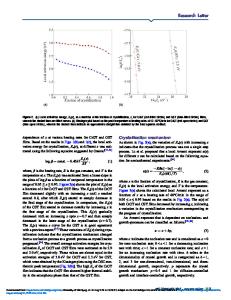Investigation on acetone sensing properties and mechanism of p-type Cr 2 WO 6 nanoparticles
- PDF / 1,687,006 Bytes
- 11 Pages / 595.276 x 790.866 pts Page_size
- 20 Downloads / 318 Views
Investigation on acetone sensing properties and mechanism of p‑type Cr2WO6 nanoparticles Chen Tian1 · Min Zhou2 · Zhongqiu Hua1 · Wenjing Yuan3 · Yi Wu1 · Xuemin Tian1 · Tao Song1 Received: 9 August 2019 / Accepted: 17 January 2020 © Springer Science+Business Media, LLC, part of Springer Nature 2020
Abstract In the present work, gas sensors based on Cr2WO6 nanoparticles were fabricated by a screen-printing technique, and the sensing properties were characterized with acetone and other typical reducing gases under both dry and humid air backgrounds. Interestingly, it was found that Cr2WO6 sensors showed a p-type conduction characteristic with a highly sensitive response to acetone vapor in a relatively low concentration. In the presence of humidity, resistances of C r2WO6 sensors were significantly increased; nevertheless, sensor responses were obviously inhibited. In addition, the basic sensing mechanism of C r2WO6 sensor was also investigated based on oxygen adsorption behavior and catalytic properties of Cr2WO6 surface. According to experimental results, it is proposed that the resistive responses of Cr2WO6 sensor to reducing gases were highly oxygendependent, indicating that the surface oxygen adsorption and reaction also played the basic role in the sensing process as that observed in typical n-type MOS sensors. Additionally, sensors also suffered from a high cross-sensitivity to water vapor due to the competition of chemisorption of water and oxygen on the surface of Cr2WO6.
1 Introduction Nowadays, almost all human activities in daily life could lead to the release of organic species to the environment, and especially in the industrial revolution, many activities have emitted the toxic gases and volatile organic compounds (VOCs) [1]. Moreover, they could be elevated the atmosphere pollution and the exposure to VOCs has serious results to human health [2]. It should be pointed out that acetone vapor exhaled by humans was also reported as an important indicator for diabetes mellitus [3]. Hence, Chen Tian and Min Zhou have contributed equally to this work. Electronic supplementary material The online version of this article (https://doi.org/10.1007/s10854-020-02935-5) contains supplementary material, which is available to authorized users. * Zhongqiu Hua [email protected] 1
Tianjin Key Laboratory of Electronic Materials and Devices, School of Electronics and Information Engineering, Hebei University of Technology, Tianjin 300401, China
2
Tianjin Hospital of Integrated Traditional Chinese and Western Medicine, Tianjin 300100, China
3
School of Material Science & Engineering, Hebei University of Technology, Tianjin 300401, China
the acetone concentrations in breath were used to monitor and detect the disease, which provided a simple, available, and convenient method in application [3]. For healthy people, the concentration of acetone is less than 0.8 ppm, while the concentrations could be higher than 1.7 ppm for diabetes patients [4]. Gas sensors based on metal oxide semicon
Data Loading...











